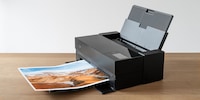
Background information
Fine Art Printing, Part 1 – basics and printers
by Samuel Buchmann

Half typewriter, half PC – word processors are a fascinating in between. I dug out the 1991 Brother LW-35.
I first came across the term «word processor» in Haruki Murakami’s novel, «1Q84». The novel is set in 1984, and from the context I concluded that it must be a primitive computer specialised in word processing. But I could never quite imagine how such a device worked.
It’s high time to figure that out – which is why I’ve got the Brother LW-35 word processor in front of me, purchased on ricardo.ch for 50 francs.
This archaeological find stems from the early 1990s and is a kind of link between the electric typewriter and the PC. It’s part computer, but simultaneously still a typewriter. In other words, it’s the Australopithecus of PCs.
The evolution from the typewriter to the PC can be divided into various intermediate stages – not all word processors are created equal. What they do have in common is that they all have a display. Instead of writing directly on paper, you type text that shows up on the display. The biggest advantage of this is that I can correct any typos before the machine prints them onto paper.
But the Brother LW-35 can do much more than just that. It allows you to work much better and more efficiently than with an ordinary typewriter.
The LCD, which is quite large, can display eleven lines of text. Line breaks are inserted automatically. On a PC, this a given; not so on a typewriter.
The word processor also supports justified text, meaning it has straight edges on both sides of the paragraph. It also allows for right-justified and centred formatting, as well as bold and underlined fonts.
And that’s not all – there’s also an onboard spell checker. I can run it over the text after the fact or, as demonstrated in the video, in real time. The Brother can store new words in the user dictionary, which can even be transferred onto another device.
The ugly dark streaks on the screen are from the backlight. If I turn it off, they disappear. In good lighting conditions, the text is legible even without backlighting.
The search and replace function probably comes in handy for long texts especially. In addition, the LW-35 can copy as well as cut and paste text. Mind you, it’s more cumbersome than on a PC, but it works. I was particularly impressed by the fact that I can display two files at the same time and copy text passages from one document to another. To top it all off, frequently used phrases can even be saved and inserted using an abbreviation.
Besides text processing, the machine also has a mode that allows you to draw lines. You can use it create and print frames or tables. Horizontal lines can be set to a single or double stroke.
Text and line files can be saved to a floppy disk – that is, they could be, if the floppy drive were still intact. I can hear that it’s broken. It emits a loud, ungodly noise when I try to feed in data. The rubber belt is most likely broken. Floppy disk drives, like cassette devices, have a rubber drive belt which degrades over time.
Replacing such a belt or even the entire drive probably isn’t rocket science. But I can’t even get the case open; there are no screws. I haven’t had any success trying to pry it open. Just the fear that I’ll inadvertently annihilate the thing.
Restoring the device doesn’t seem worth the effort to me, as it has a few other flaws, too. It’s very dirty, plus there are streaks coming from the backlight. And, above all, I don’t seem to be able to type an exclamation mark. The keyboard uses the Swiss layout, meaning the «1» key doesn’t double as an exclamation mark, but a plus. The exclamation mark should be to the left of the «ü», but only the umlaut dots and other accents are located there.
In the final step, I print out the text. Really, you can think of the Brother LW-35 as a simple PC with a built-in printer. What’s so special about it? It’s a daisy-wheel printer. It prints much more beautifully than the dot-matrix printers common in the 1980s and is more reliable than the inkjet printers that emerged in the early 1990s. Laser printers also existed at that time, but they were unaffordable monstrosities – so opting for a daisy-wheel printer was definitely justified.
You’ve just read Part 3 of my unofficial printer denial series (Part 1, Part 2). I can hardly believe it myself, but this device has helped me mend fences with the concept of a printer.
My interest in IT and writing landed me in tech journalism early on (2000). I want to know how we can use technology without being used. Outside of the office, I’m a keen musician who makes up for lacking talent with excessive enthusiasm.